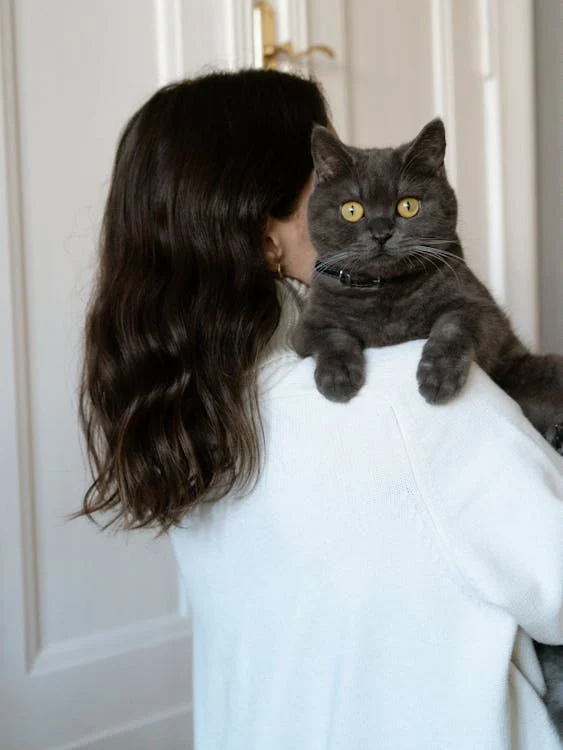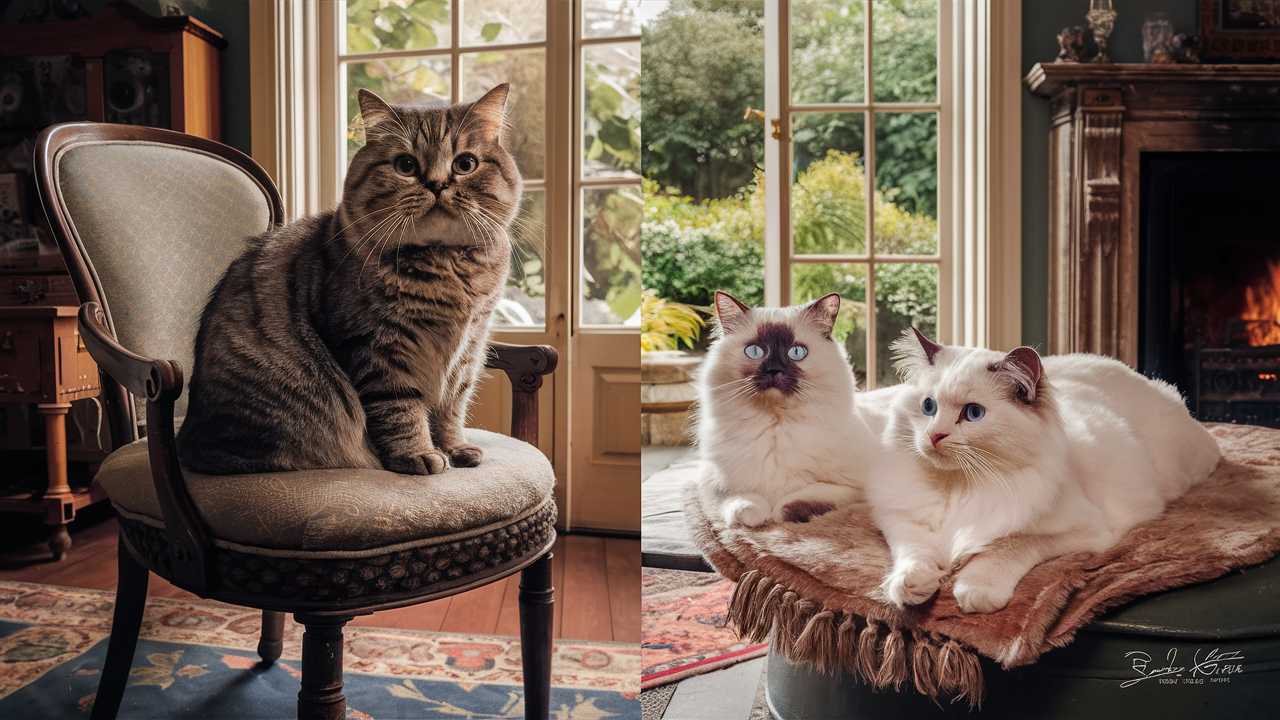Are you considering adding a feline friend to your home but can’t decide between a British Shorthair and a Ragdoll? These two popular cat breeds are beloved for their unique personalities, adorable appearances, and charming traits.
However, they have significant differences in temperament, grooming needs, and the type of companionship they offer. British Shorthairs are more independent, low-maintenance, and prefer occasional affection, while Ragdolls are affectionate, social, and love being around their owners.
In this guide, we’ll explore the key differences between British Shorthair and Ragdoll cats to help you make the best choice for your home.
Main differences
| Feature | British Shorthair | Ragdoll |
|---|---|---|
| Weight | 9-18 lbs (4-8 kg) | 10-20 lbs (4.5-9 kg) |
| Height | 12-14 inches (30-35 cm) | 9-11 inches (23-28 cm) |
| Personality | Independent, calm | Affectionate, gentle |
| Suitable For | Busy or working households | Families, companionship |
| Price | $800 – $2,500 | $1,000 – $2,500 |
| Lifespan | 12-20 years | 12-15 years |
British Shorthair Overview
The British Shorthair is one of the oldest cat breeds, with roots tracing back to ancient Rome. When the Romans invaded Britain, they brought these cats along to protect food supplies by keeping the rodent population in check.
Over the centuries, British Shorthairs adapted to the local environment, eventually becoming one of the most cherished cat breeds in the United Kingdom. They gained recognition as a formal breed in the 19th century, and their popularity has only grown since then.
Physical Appearance
British Shorthairs have a robust, muscular, and cobby body type with a broad chest and short, sturdy legs. They have a round face with full cheeks, large round eyes that can be copper, blue, green, or gold depending on the coat color, and small, rounded ears. Their coat is short, dense, and plush, giving them a soft yet resilient feel.
The classic British Blue color is most recognized, but they come in a variety of colors and patterns, including tabby, white, black, and cream. They typically weigh between 7-17 pounds, with males being larger and heavier compared to females.
Their coat can come in a wide range of colors and patterns, but the iconic blue-gray (often called “British Blue”) is the most well-known and popular.

Personality and Temperament
British Shorthairs are known for their calm, dignified demeanor. They are independent but affectionate, making them a great choice for those who want a loving pet without the need for constant attention.
They tend to be reserved around strangers but are deeply loyal to their family members. British Shorthairs are not typically lap cats, but they enjoy being near their humans and will often follow them from room to room, showing their affection in a quiet, understated way.
Both breeds are relatively low-energy compared to more active cat breeds, but there are differences in how they spend their time. British Shorthairs are generally more laid-back and enjoy lounging around the house. They do like to play, but they prefer short bursts of activity followed by long naps.
Grooming and Maintenance
British Shorthairs have a short, dense coat that requires minimal grooming compared to longhaired breeds. Brushing them once a week is usually sufficient to remove loose hairs and keep their coat looking their best.
During shedding seasons, which typically occur in the spring and fall, more frequent brushing can help manage the extra fur. The British Shorthair’s entire body, including its back, sides, and underbelly, should be brushed to prevent matting and reduce shedding.
Their dense fur can sometimes trap dirt, so regular brushing also helps to maintain cleanliness.
Health and Care
British Shorthairs are generally healthy cats but can be prone to specific health issues, including hypertrophic cardiomyopathy (HCM), a common heart condition in cats. They are also susceptible to obesity due to their love of lounging, so it’s important to monitor their diet and encourage regular play to keep them at a healthy weight.
British Shorthairs may also be prone to dental disease, so regular dental checkups and good oral hygiene are important. Regular veterinary checkups are crucial to monitor their health and catch any potential issues early.

Ragdoll Overview
The Ragdoll breed originated in the 1960s in Riverside, California, by breeder Ann Baker. She developed the breed from a domestic longhaired cat named Josephine, who had a reputation for her relaxed, easygoing nature.
Baker selectively bred cats with similar temperaments to create what we now know as the Ragdoll, a breed famous for its affectionate personality and tendency to go limp when picked up—hence the name “Ragdoll.”
Physical Appearance
Ragdolls are known for their large size and semi-longhaired, silky coat. They have a slender, yet muscular build with a long body, and long legs that give them a more elegant appearance compared to the British Shorthair. Ragdolls have distinctive bright blue eyes, and their coat patterns include colorpoint, mitted, and bicolor.
They typically weigh between 10-20 pounds, with males often reaching up to 20 pounds or more, while females are usually lighter.

Personality and Temperament
Ragdolls are often described as “puppy-like” due to their affectionate, social nature. They thrive on human interaction and are known for being incredibly gentle and tolerant. Unlike British Shorthairs, Ragdolls are true lap cats and love being held and cuddled.
They are also known for their relaxed temperament, often going completely limp when picked up, making them one of the most docile and laid-back cat breeds. They get along well with children, other cats, and even dogs.
Ragdolls are also relaxed but are more playful and enjoy interactive toys and games. They are more likely to engage in fetch or follow their owners around, showing a higher level of interest in interactive play.
| Personality and Temperament | British Shorthairs | Ragdolls |
|---|---|---|
| Independence | ✓ | – |
| Sociability | – | ✓ |
| Adaptability | – | ✓ |
Grooming and Maintenance
Ragdolls, with their semi-longhaired coat, need more regular grooming to prevent tangles and matting. Brushing them two to three times a week helps maintain their silky coat and reduces shedding.
In addition to brushing, it’s important to check and groom the entire body, including the legs, chest, and tail, as these areas can easily develop mats. Regular grooming also provides an excellent opportunity to bond with your Ragdoll, as they generally enjoy the attention.
Clipping their nails, cleaning their ears, and ensuring their eyes are free of discharge are also essential parts of Ragdoll’s grooming routine.
Health and Care
Ragdolls are also prone to HCM, which is a genetic condition that should be monitored closely. In addition to heart issues, Ragdolls can be at risk for bladder stones and urinary tract issues. Their relaxed nature means they may be less active, which can lead to obesity if their diet is not carefully managed.
Ragdolls also benefit from regular dental care to prevent gum disease and tooth decay. Regular vet visits are essential to ensure their overall health, and genetic screening for HCM is recommended for Ragdolls to detect any underlying conditions early.

Which Breed is Right for You? Ragdoll vs British shorthair cat
British Shorthairs are independent, reserved, and easygoing, while Ragdolls are affectionate, social, and thrive on human interaction. Choosing between them largely depends on your lifestyle and the type of companionship you desire.
Guidance: If you prefer a cat that is affectionate yet independent and doesn’t require constant attention, the British Shorthair may be a better fit. They are well-suited for people who appreciate a companion that enjoys their presence but is not overly demanding.
On the other hand, if you want a cat that will actively seek out your company, follow you around, and cuddle on your lap, the Ragdoll is an excellent choice. They are perfect for households where someone is often home and can give them the love and attention they crave.
FAQs
Q1. Are British Shorthairs or Ragdolls better with kids?
Both breeds are good with children, but Ragdolls are generally more tolerant of handling and enjoy being around people, making them great for families with young kids. British Shorthairs are also good with kids but may prefer to interact on their terms.
Q2. Which breed is more affectionate?
Ragdolls are more affectionate and are known for their love of cuddles, while British Shorthairs are affectionate in a more reserved manner, enjoying proximity without being overly clingy.
Q3. Do British Shorthairs and Ragdolls get along with other pets?
Yes, both breeds can get along well with other pets. Ragdolls are particularly social and friendly, often making friends with other cats and even dogs. British Shorthairs may take some time to warm up to new companions but generally coexist peacefully once they are comfortable.
Conclusion
In conclusion, both British Shorthair and Ragdoll cats have unique qualities that make them wonderful companions. British Shorthairs are dignified, independent, and easygoing, while Ragdolls are affectionate, social, and thrive on interaction. Understanding their differences in appearance, temperament, grooming needs, and health considerations can help you decide which breed best fits your lifestyle.
Whether you prefer the calm and reserved British Shorthair or the loving and playful Ragdoll, both breeds are sure to bring joy and companionship to your home.

Hey guys, My name is Simon Smith. I’m from Canada and live near Victoria
I live with my sweet family and have 20+ Ragdolls of different types. I love them as my children. My profession is as a hotel manager.
I love to keep Ragdolls and grow their breeder case. I have 7 years of experience.
I’m an expert in cat care. So, I’m here to provide you with new information about my cats daily. This is my blog website, so I request that you kindly visit our site daily.
If you’re a Ragdolls lover and you have any questions or confusion about cats, text me on the Contact Us page or Gmail.
Thank u
